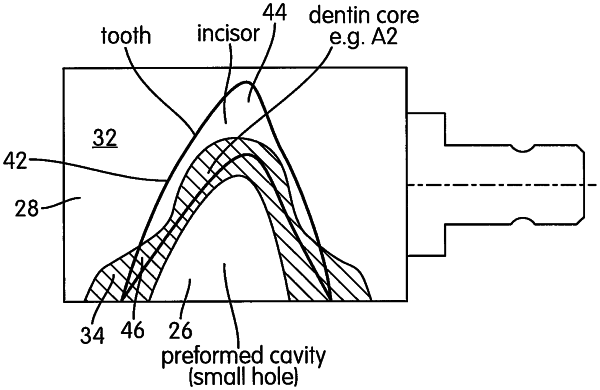| CPC A61C 13/0022 (2013.01) [A61C 5/70 (2017.02); A61C 5/77 (2017.02); A61C 13/0006 (2013.01); A61C 13/082 (2013.01); A61C 13/083 (2013.01); A61C 13/09 (2013.01); A61K 6/818 (2020.01); A61K 6/822 (2020.01); A61K 6/824 (2020.01); A61K 6/833 (2020.01); B29C 43/146 (2013.01); A61C 9/0046 (2013.01); B29C 43/203 (2013.01); B29C 2043/147 (2013.01); B33Y 80/00 (2014.12)] | 14 Claims |

|
1. A method for the production of a blank of a ceramic material comprising the steps of:
providing a first starting glass composition in percentage by weight:
| ||||||||||||||||||||||||||||||||||||||||
and
wherein Tb2O3 and/or Er2O3 are added to the first starting glass composition to influence fluorescence;
heat treating the first starting glass composition at a temperature between 1350° C. and 1600° C. to form a first melt;
quenching the first melt to form a first glass frit;
working the first glass frit to form a first glass powder having a grain size ranging from 1 to 150 microns;
heat treating the first glass powder at a temperature from 600° C. to 860° C. to form a first lithium silicate glass ceramic powder;
providing a second starting glass composition in percentage by weight:
| ||||||||||||||||||||||||||||||||||||||||
and
wherein Tb2O3 and/or Er2O3 are added to the second starting glass composition to influence fluorescence; and
wherein the first starting glass composition is different than the second starting composition;
heat treating the second starting glass composition at a temperature between 1350° C. and 1600° C. to form a second melt;
quenching the second melt to form a second glass frit;
working the second glass frit to form a second glass powder having a grain size ranging from 1 to 150 microns;
heat treating the second glass powder at a temperature from 600° C. to 860° C. to form a second lithium silicate glass ceramic powder that is different from the first lithium silicate glass ceramic powder;
wherein both the first lithium silicate glass ceramic powder and the second lithium silicate glass ceramic powder include lithium silicate crystals in the range of 10-80% by volume;
filling a layer of the first lithium silicate glass ceramic powder into a mold;
forming a first open cone-shaped cavity in the layer of the first lithium silicate glass ceramic powder;
filling the first cone-shaped open cavity with the second lithium silicate glass ceramic powder;
pressing the first and second lithium silicate glass ceramic powders thereby forming a first region corresponding to an area of the first lithium silicate glass ceramic powder and a second region corresponding to an area of the second lithium silicate glass ceramic powder; and
sintering the pressed first and second lithium silicate glass ceramic powders;
wherein the second lithium silicate glass ceramic powder of the second region is colored and the first lithium silicate glass ceramic powder of the first region is not colored or colored to a lesser degree, so that a higher translucency in the second region relative to the first region results.
|
||||||||||||||||||||||||||||||||||||||||